Multi-Residue Pesticide Screening Method Using GC–MS
The Application Notebook
Pesticides are widely used by farmers to control pests, weeds and molds that would otherwise decrease crop production. While this has significantly increased worldwide food productions, these same pesticides pose health risks to humans. The restrictions for specific pesticides differ from one country to the next and as world trade increases, the potential threat to other countries' populations increases. For this reason, pesticides and other food related allergens are currently the subjects of increasing scrutiny and regulation.
Sky Countryman and Kory Kelly, Phenomenex Inc., Torrance, California, USA.
Pesticides are widely used by farmers to control pests, weeds and molds that would otherwise decrease crop production. While this has significantly increased worldwide food productions, these same pesticides pose health risks to humans. The restrictions for specific pesticides differ from one country to the next and as world trade increases, the potential threat to other countries' populations increases. For this reason, pesticides and other food related allergens are currently the subjects of increasing scrutiny and regulation.

Table 1
There are more than 500 different pesticides used throughout the world, so it is very difficult to tell what pesticide a food product might have been treated with. To ensure consumer safety, multi-residue screening approaches are being developed to analyse as many pesticides as possible.
The Zebron ZB-MultiResidue-1 was specifically designed to improve resolution of multi-pesticide samples. The column is manufactured using a dimethylpolysiloxane backbone giving the column MS certified bleed levels and temperature limits up to 320/340 °C (Isothermal/TPGC). However the functional group that gives the column its unique selectivity was specifically developed for pesticide compounds. When compared to a standard 5%-phenyl 95%-dimethylpolysiloxane phase, the ZB-MultiResidue-1 provides much better peak shape for the more polar pesticides and improves resolution for close eluting compounds.

Figure 1
Figure 1 shows a multi-pesticide residue analysis of a mix of more than 100 commonly tested organochlorine, organophosphorous and nitrogen containing pesticides. Comparisons have been run, though data not shown here, against 5ms type phases which demonstrate the improved resolution and peak shape for various pesticides such as bromacil and terbacil. Additional retention time data for over 300 additional pesticides is available upon request.
Phenomenex Inc.
411 Madrid Avenue, Torrance, California 90501, USA
tel. +1 310 212 0555 fax +1 310 328 7768
E-mail: info@phenomenex.com
Website: www.phenomenex.com


University of Rouen-Normandy Scientists Explore Eco-Friendly Sampling Approach for GC-HRMS
April 17th 2025Root exudates—substances secreted by living plant roots—are challenging to sample, as they are typically extracted using artificial devices and can vary widely in both quantity and composition across plant species.
Sorbonne Researchers Develop Miniaturized GC Detector for VOC Analysis
April 16th 2025A team of scientists from the Paris university developed and optimized MAVERIC, a miniaturized and autonomous gas chromatography (GC) system coupled to a nano-gravimetric detector (NGD) based on a NEMS (nano-electromechanical-system) resonator.
Characterizing Plant Polysaccharides Using Size-Exclusion Chromatography
April 4th 2025With green chemistry becoming more standardized, Leena Pitkänen of Aalto University analyzed how useful size-exclusion chromatography (SEC) and asymmetric flow field-flow fractionation (AF4) could be in characterizing plant polysaccharides.










